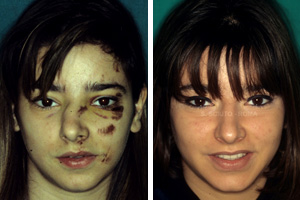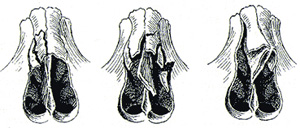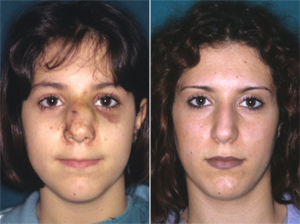

Road accident with fracture of nasal bones. Right: two months after the reduction.

Several types of nasal fractures (from Converse).

Effects of fracture of the nasal bones. Though suitably treated at the time of the trauma, the fracture led to the formation of a moderate bony callus many years later. A rhinoplasty can correct it.
I have fractured my nasal bones
A fracture of the bones of the nose can be the result of a trauma that applies a force to the nose of at least 15-30 Kg per square inch. At the moment of the trauma an acute pain is felt that often has a short duration.
Sometimes blood will flow from the nostrils and this generally stops spontaneously. It can happen that the external nose will swell and this swelling may hide that the nose is distorted or that the profile has changed.
Only after some time, when the swelling of the trauma subsides, we observe the deformity that can be a "shifting" to the side of the nasal pyramid or flattening of the nose.
What can be done?
In the case of a forceful trauma to the nose an x-ray and a specialist visit can confirm the presence of a fracture that needs reduction. Moreover an examination of the inner nose can exclude the presence of septal hematoma. This is a complication of nasal trauma that manifests as complete obstruction of the nostrils and can bring about serious consequences, not only aesthetically, if not seen to in a prompt manner.
Generally the sooner a fracture of the nasal septum is reduced the better the outcome. However, although the maximum time limit considered by some is up to 3 weeks after the trauma, it is reasonable to try to carry out the surgery within 4 - 7 days of the incident.
The surgery of nasal bone fracture consists of realigning bone fragments to their correct position so that they can knit in the correct way without leaving external signs of the trauma. If the fracture is not complex and little time has passed since the incident the surgery will generally be carried out under local anesthesia. If instead the fracture is complex or more than seven days have passed then general anesthesia is preferable.
In both cases all the steps are carried out from within the nostrils. Nasal packing can sometimes be necessary, while rigid protection outside the nose for seven days is always necessary. It can sometimes happen that, even when the fracture has been reduced perfectly, a large bony callus forms on the nasal dorsum over time and is therefore visible outside as a hump.
This is a phenomenon related to the normal process of healing of bones and is neither predictable nor preventable. When this happens, if you wish to return your nose to its former shape before the trauma, it is necessary to undergo a rhinoplastic surgery.